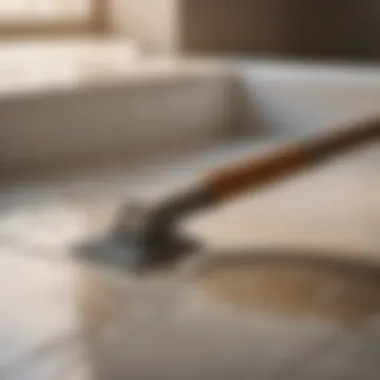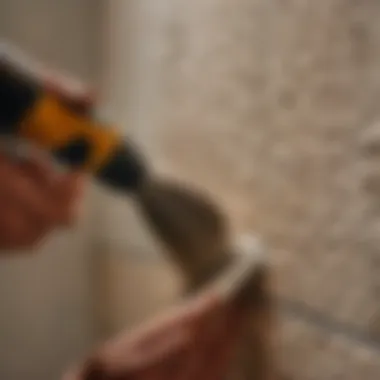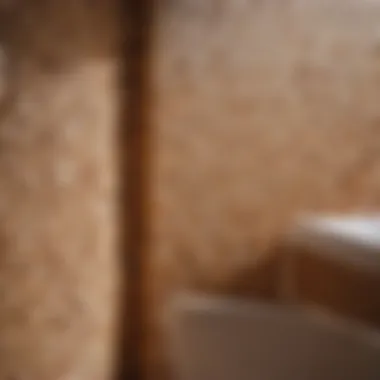Expert Tips for Regrouting Your Bathroom Like a Pro - A Step-by-Step Guide


Materials:
- Grout removal tool: Purchase a durable grout saw with a comfortable grip
- Grout: Select high-quality grout in the desired color
- Grout sealant: Invest in a reputable sealant to protect the grout from moisture and stains
- Sponge: Obtain a large sponge suitable for grout cleaning
- Bucket: Use a medium-sized bucket for mixing grout
- Grout float: Opt for a rubber-tipped grout float for smooth application
- Gloves: Secure a pair of protective gloves for hand safety
DIY Steps:
- Start by removing the old grout with the grout removal tool, ensuring all traces are cleared
- Prepare the new grout mixture according to the manufacturer's instructions in the bucket
- Apply the new grout using the grout float, pressing firmly into the gaps
- Use the sponge to clean off excess grout and smooth the surface
- Allow the grout to cure as per the sealant recommendations
- Seal the grout to enhance durability and prevent stains
Technical Aspects:
- Timing: Allocate a sufficient amount of time for each step to prevent rushing
- Tools: Ensure all tools are in optimal condition before starting the project
- Techniques: Employ proper grout application techniques for a flawless finish
DIY Project Process:
- Begin by carefully removing the old grout, taking care not to damage the surrounding tiles
- Mix the new grout to the desired consistency and work in small sections for efficiency
- Maintain a clean work area to prevent grout residue from hardening on surfaces
- Troubleshooting Tips: In case of uneven grout application, gently remove excess and reapply for consistency
Introduction
In the realm of home upkeep, maintaining a pristine bathroom is paramount for a feeling of cleanliness and comfort. One often overlooked yet essential aspect of bathroom upkeep is grout maintenance. This definitive guide on how to regrout your bathroom delves deep into the intricacies of this process, offering a comprehensive walkthrough that will leave your bathroom looking fresh and rejuvenated.
Understanding Grout
When embarking on a regrouting project, it's crucial to understand the different types of grout available and the signs that indicate deteriorating grout. Let's explore these aspects in detail:
Types of Grout
Grout comes in various types, each with its unique characteristics and benefits. For instance, epoxy grout is known for its exceptional durability and resistance to stains, making it an excellent choice for high-moisture areas like bathrooms. On the other hand, sanded grout is preferred for wider grout lines due to its added strength. Understanding the nuances of each grout type ensures you select the most suitable option for your regrouting project, ultimately contributing to a long-lasting and visually appealing finish.
Signs of Deteriorating Grout
Recognizing the signs of deteriorating grout is crucial for timely intervention to prevent extensive water damage and mold growth. Common indicators include cracks, discoloration, and crumbling grout. By identifying these signs early on, you can address potential issues swiftly, preserving the integrity of your tiled surfaces and avoiding costly repairs down the line.
Stay tuned for the upcoming sections where we delve into the nitty-gritty of preparing for and executing a successful regrouting project!
Preparation


In the realm of regrouting your bathroom, preparation is an absolutely vital step that sets the foundation for a successful project. This phase is where attention to detail and meticulous planning can make a significant difference in the final outcome. Proper preparation ensures that you have all the necessary tools and materials at hand, enabling a smooth progression through the subsequent stages of regrouting. By focusing on thorough preparation, you can achieve a more professional finish and extend the longevity of your bathroom's grouting.
Gathering Tools and Materials
Grout removal tool:
The grout removal tool is a crucial element in the regrouting process, designed to efficiently remove old and worn-out grout from between tiles. Its key characteristic lies in its sturdy and precise construction, which allows for targeted grout removal without damaging the surrounding tiles. This tool is a popular choice for this article due to its effectiveness in preparing the surface for new grout application. A unique feature of the grout removal tool is its interchangeable tips, offering versatility and adaptability for different types of grout removal tasks. While it provides exceptional precision and control, one drawback is that it may require some physical effort to operate, especially in stubborn grout removal scenarios.
New grout:
New grout serves as the backbone of the regrouting process, responsible for filling the gaps between tiles and securing them in place. Its key characteristic lies in its composition, which ensures durability and water resistance, essential for maintaining the integrity of bathroom surfaces. Chosen for its reliability and performance, new grout is a popular choice for this article as it guarantees long-lasting results and enhances the aesthetic appeal of tiled areas. A unique feature of new grout is its range of colors, allowing for customization and creative design possibilities. While new grout excels in providing a seamless finish, one potential disadvantage is the setting time required for optimal curing.
Grout float:
The grout float plays a crucial role in spreading new grout evenly and effectively into the joints between tiles. Its key characteristic lies in its flat rubber base, which ensures smooth and consistent grout application without leaving excess residue on tile surfaces. This tool is a beneficial choice for this article due to its ergonomic design, which enhances comfort and control during application. A unique feature of the grout float is its angled edges, enabling precise grout placement even in tight or awkward spaces. While the grout float excels in achieving a professional finish, one limitation is that it requires proper cleaning after each use to prevent grout buildup affecting future applications.
Grout sealer:
Grout sealer acts as a protective barrier, safeguarding the grout against moisture penetration, stains, and mold growth. Its key characteristic lies in its penetrative formula, which effectively seals the grout pores and enhances its longevity. This sealer is a beneficial choice for this article due to its role in preserving the new grout and simplifying maintenance routines. A unique feature of the grout sealer is its applicator nozzle, enabling precise and controlled distribution without wasting excess product. While the grout sealer offers valuable protection, one drawback is that multiple coats may be required for optimal sealing, extending the application time.
Preparing the Area
In the regrouting process, preparing the area where work will be conducted is essential to safeguard surrounding surfaces and achieve a clean and professional finish. This phase involves creating a suitable workspace that allows for efficient grout removal and application without causing damage to adjacent areas. By focusing on preparing the area comprehensively, you can streamline the regrouting process and ensure the longevity of your bathroom's new grout.
Cleaning the grout lines:
Cleaning the grout lines is a critical aspect of area preparation, aiming to remove dirt, grime, and debris accumulated over time. Its key characteristic lies in its deep-cleaning action, which restores the original color of the grout and eliminates mold and mildew growth. This step is a beneficial choice for this article as it establishes a clean and sanitized surface for new grout application. A unique feature of cleaning the grout lines is its rapid-drying formulation, which minimizes wait times between cleaning and grouting. While this process excels in rejuvenating the grout appearance, one consideration is to use gentle cleaning solutions to avoid damaging the grout's integrity.
Protecting surrounding surfaces:
Protecting surrounding surfaces is crucial in preventing accidental damage or staining during the regrouting process. Its key characteristic lies in its barrier function, shielding walls, fixtures, and floors from grout splatter and adhesive residues. This precaution is a popular choice for this article as it ensures a clean and polished outcome without additional cleanup efforts. A unique feature of protecting surrounding surfaces is the use of masking tape and plastic sheeting, which provide easy removal after grouting. While this protective measure safeguards surfaces effectively, one caution is to secure the protective materials well to prevent shifting or slippage during grout application.
Ensuring Proper Ventilation
Proper ventilation is vital during the regrouting process to promote airflow and minimize exposure to harsh fumes or dust particles. Adequate ventilation enhances comfort and safety for individuals undertaking the project, ensuring a healthy and breathable environment throughout the regrouting procedure. By focusing on proper ventilation, you can optimize the regrouting experience and facilitate the drying and curing of new grout.


Opening windows:
Opening windows is a simple yet effective method of ventilating the workspace, allowing fresh air to circulate and stale air to escape. Its key characteristic lies in its accessibility, offering natural ventilation that reduces odors and promotes air quality. This approach is a beneficial choice for this article as it provides a cost-effective and eco-friendly solution for maintaining a well-ventilated environment during regrouting. A unique feature of opening windows is the ability to create cross-ventilation, which accelerates air exchange and improves overall ventilation efficiency. While opening windows enhances airflow and comfort, one consideration is to ensure security by installing window locks or safeguards to prevent intrusions.
Using a fan:
Using a fan complements natural ventilation by enhancing air circulation and expediting the dispersion of fumes or airborne particles. Its key characteristic lies in its adjustable speed settings, which allow for customized airflow direction and intensity. This option is a practical choice for this article as it amplifies ventilation effectiveness, especially in enclosed spaces or poorly ventilated bathrooms. A unique feature of using a fan is its oscillating function, which distributes airflow evenly across the workspace, promoting consistent air quality. While a fan improves ventilation and comfort levels, one potential drawback is the noise generated, requiring consideration for noise-sensitive individuals or households.
Grout Removal
Grout removal is a crucial step in the regrouting process. By removing old and deteriorating grout, you create a clean surface for the application of fresh grout, ensuring a durable and aesthetically pleasing result. Proper grout removal helps in preventing mold and mildew growth, as well as improving the overall hygiene of your bathroom. It also promotes better adherence of the new grout, enhancing its longevity and effectiveness.
Removing Old Grout
Using a Grout Saw
Using a grout saw is a meticulous and effective method for removing old grout. The key characteristic of a grout saw lies in its small, sharp blade that easily cuts through the grout lines without damaging the surrounding tiles. This tool is a popular choice for grout removal due to its precision and control, allowing you to target specific areas with precision. One unique feature of using a grout saw is its ability to reach narrow or hard-to-reach spaces, ensuring thorough grout removal even in tight corners. While using a grout saw provides accurate results, it requires patience and steady hands to avoid any accidental tile damage. However, its precision and efficiency make it a valuable asset in achieving a clean surface for regrouting.
Using a Rotary Tool
Utilizing a rotary tool is another efficient approach to grout removal. The key characteristic of a rotary tool is its versatility, offering a range of attachments suitable for different grout types and sizes. This tool is favored for its speed and ease of use, allowing for quicker grout removal compared to manual methods. A unique feature of a rotary tool is its ability to adjust speed and depth, providing flexibility in tackling various grout removal tasks. While using a rotary tool speeds up the process, it may generate more dust and require careful handling to prevent tile damage. Despite these considerations, its quick and precise performance makes it a popular choice for efficient grout removal in the regrouting process.
Regrouting Process
In the realm of bathroom maintenance, the rite of passage known as the Regrouting Process holds a paramount importance that cannot be overlooked. As the lines of grout in your bathroom wear down and lose their lustre over time, investing in regrouting not only revitalizes the aesthetic appeal of your space but also ensures the longevity of your tiles. In this comprehensive guide on how to regrout your bathroom, the Regrouting Process stands as a pivotal stage that demands precision and care to achieve a flawless finish. By mastering each element of this process, you are not only enhancing the visual allure of your bathroom but also safeguarding it against potential water damage and grime build-up.
Mixing the New Grout
When delving into the realm of regrouting, the Mixing the New Grout stage serves as the cornerstone of the entire process. Achieving the perfect consistency in your grout mixture is essential for a successful makeover of your bathroom tiles. Consistency here refers to the thickness and smoothness of the grout mixture, which directly impacts its ability to fill in the gaps between tiles effectively. For the ultimate goal of durable and visually appealing grout lines, maintaining the right consistency is key. A mix that is too thin may lead to cracking and degradation, while a mix that is too thick can be challenging to work with and may not adhere well to the surface. By focusing on achieving the ideal consistency, you set the foundation for impeccable grout lines that will stand the test of time.
Adding Water Gradually
The process of Adding Water Gradually to your grout mixture is a delicate dance of precision and patience. This technique allows you to control the hydration level of the grout, ensuring that it reaches the perfect consistency without becoming lumpy or watery. By incorporating water gradually, you have the flexibility to adjust the thickness of the mixture according to your specific needs. This method not only grants you more control over the final result but also minimizes the risk of over-watering, which can compromise the strength and durability of the grout. Embracing the practice of Adding Water Gradually empowers you to fine-tune your grout mixture to perfection, ultimately leading to a stunning finish that exudes craftsmanship and quality.
Applying the New Grout


Transitioning from the mixing stage to the application phase, the Applying the New Grout step is where the magic truly happens. Utilizing a grout float to spread the mixture evenly across the tiles, you embark on a journey of precision and finesse. The key characteristic of Using a Grout Float lies in its ability to push the grout deep into the joints between tiles, ensuring robust adhesion and uniformity. By employing this tool with a steady hand and gentle pressure, you guarantee that every nook and cranny is filled with precision, leaving behind no room for imperfections. Filling the joints evenly is a meticulous task that requires attention to detail, as the seamless integration of the new grout elevates the overall appearance of your bathroom tiles to a level of unparalleled sophistication.
Cleaning Excess Grout
As you near the completion of the grouting process, the importance of Cleaning Excess Grout cannot be overstated. Using a damp sponge, you delicately wipe away the surplus grout from the tile surface, revealing the gleaming beauty beneath. The key characteristic of Using a Damp Sponge lies in its ability to remove grout residue without scratching or damaging the tiles. This gentle approach ensures that your newly grouted tiles retain their pristine condition, free from smudges and stains. Avoiding over-wetting is a crucial aspect of this step, as excess moisture can weaken the grout lines and lead to unsightly patches or discoloration. By following this meticulous cleaning routine, you preserve the integrity of your grout work and unveil a flawless finish that exudes elegance and sophistication.
Sealing the Grout
As the final step in the regrouting process, Sealing the Grout serves as the ultimate assurance of longevity and durability. Choosing the right sealer is paramount in safeguarding your freshly grouted tiles against moisture, stains, and mildew. The key characteristic of selecting the appropriate sealer lies in its compatibility with your grout type and tile material, ensuring optimal protection and longevity. By exploring different Application Techniques, you can find the method that best suits your specific grouting needs, whether it be brush-on sealers, spray sealers, or roll-on sealers. Each technique offers distinct advantages and considerations, allowing you to customize your sealing process for maximum effectiveness. As you embark on this final stage of the regrouting journey, you seal in the beauty of your hard work and dedication, creating a stunning bathroom oasis that radiates with freshness and allure.
Finishing Touches
When it comes to regrouting your bathroom, the Finishing Touches section is an integral part of the process that adds the final polish to your efforts. These finishing touches not only enhance the aesthetics but also contribute to the longevity of your newly regrouted bathroom. It ensures that the grout is sealed properly and the surfaces are clean and polished, providing a professional finish to your project.
In this article, we delve into the specific elements of Finishing Touches that are crucial for achieving a flawless result. From removing any grout haze to polishing the tiles, each step plays a significant role in elevating the overall look of your bathroom. By paying attention to these details, you can enjoy a bathroom that looks fresh, clean, and professionally regrouted.
Final Cleanup
Removing any Grout Haze
Removing any grout haze is a pivotal step in the regrouting process as it ensures that the tiles are free from any residue that may detract from their appearance. This involves using a damp sponge to gently wipe away any haze that forms on the tiles as the grout dries. The key characteristic of this step is its ability to provide a clean and polished finish to the tiles, leaving them looking pristine and renewed.
One of the main advantages of removing any grout haze is that it enhances the overall aesthetic of the bathroom by highlighting the tiles' colors and patterns. Additionally, it prevents the grout haze from hardening and becoming more challenging to remove later on. This method is a popular choice in regrouting projects due to its effectiveness in achieving a professional finish.
Polishing the Tiles
Polishing the tiles is the final touch that brings out the natural shine and luster of your tiles, giving them a glossy finish. This step not only enhances the visual appeal of the tiles but also helps in sealing the surfaces, making them more resistant to dirt and grime. The unique feature of polishing the tiles is its ability to rejuvenate old tiles and make them look brand new.
An advantage of polishing the tiles is that it adds a layer of protection, making them easier to clean and maintain in the long run. However, one should be cautious as over-polishing can lead to a slippery surface, especially in wet areas like bathrooms. Therefore, striking the right balance is essential to reap the full benefits of this final touch in regrouting your bathroom.
Maintenance Tips
Maintenance tips are crucial in ensuring the longevity and quality of the regrouting project in your bathroom. By following these maintenance tips, you can preserve the newly applied grout and keep your bathroom looking fresh and clean for an extended period. Regular upkeep is key to preventing issues such as grout deterioration and discoloration. These tips not only maintain the aesthetic appeal of your bathroom but also extend the lifespan of the grout, saving you time and money on repairs and regrouting projects.
Preserving the New Grout
Regular cleaning
Regular cleaning plays a pivotal role in preserving the new grout in your bathroom. By regularly cleaning the grout lines with a mild cleaning solution and a soft brush, you can prevent dirt, grime, and mold from accumulating in the porous grout surface. The gentle cleaning process helps maintain the integrity of the grout and prevents staining, ensuring a bright and uniform appearance. Regular cleaning also facilitates the early detection of any potential issues, allowing you to address them promptly and avoid extensive damage.
Avoiding harsh chemicals
Avoiding harsh chemicals is essential for safeguarding the newly applied grout. Harsh chemicals found in many commercial cleaners can strip away the protective sealant on the grout, leading to rapid deterioration and discoloration. Opting for gentle, pH-neutral cleaners preserves the grout's integrity while effectively removing dirt and stains. By avoiding harsh chemicals, you maintain the quality and appearance of the grout, prolonging its lifespan and ensuring a pristine finish in your bathroom.







